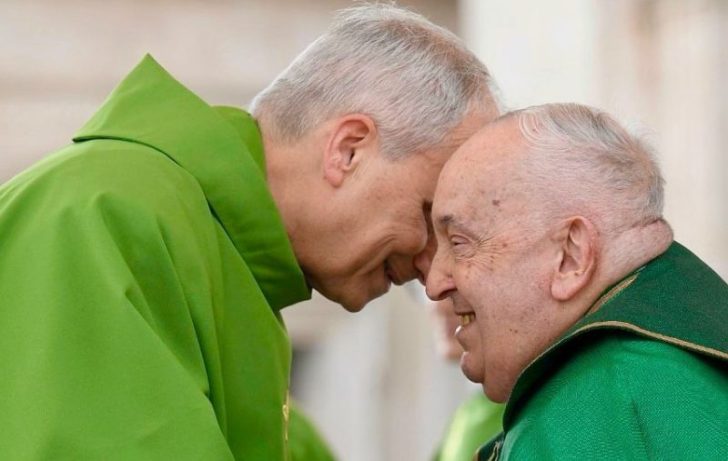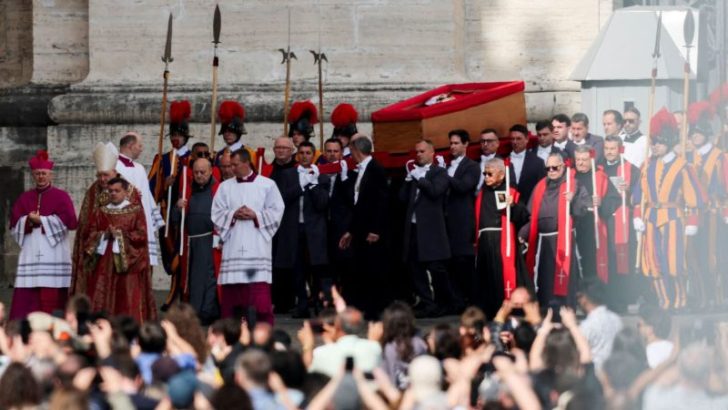Pope Francis has died at 88, and the world is showing up to say goodbye. His body now lies in state at St. Peter’s Basilica, where lines of mourners snake through the square, waiting to pay their last respects. For three days, tens of thousands will walk past his open casket, many with tears, prayers, and personal memories.
The Vatican announced Pope Francis’s death on Easter Monday, March 11, 2025. He died of a stroke and heart failure in his Vatican residence. His passing marks the end of a bold and sometimes turbulent era in the Catholic Church.
But more than that, it marks the loss of a pope who brought real-world issues to the altar.
He Was the People’s Pope
Born Jorge Mario Bergoglio, Pope Francis became the first Latin American pope in 2013. He spoke loudly for the environment, the poor, and peace. He wasn’t afraid to challenge systems or speak out against injustice, which made him beloved by many and criticized by some. Either way, people listened.

Pope Francis / IG / At St. Peter’s, the scene is powerful. Silence hangs heavy, broken only by quiet prayers and the soft shuffling of feet. His coffin rests under the grand dome, surrounded by flowers and candlelight.
Cardinals stand guard. People from around the world - pilgrims, tourists, locals - move slowly, eyes fixed on the man who once waved from this very spot.
A Global Farewell in Process
This public mourning will last for three days before his funeral on Saturday. The Vatican expects even larger crowds, with heads of state, religious leaders, and ordinary people coming to honor the late pontiff. For many, this is a once-in-a-lifetime moment.
He once said death was “a new beginning.” That quote will be published in a final message scheduled for release later this week. The timing feels almost planned, fitting for a man who never missed a moment to reflect deeply, even in farewell.
A Legacy of Peace and Action
Pope Francis didn’t just talk about change. He pushed for it. He battled internal Church politics and global issues at the same time. He reformed Church laws, opened conversations around hot-button topics, and prioritized climate change like no pope before him. He challenged the wealthy and powerful and focused on those often forgotten.

GNN / IG / As cardinals begin to gather, the process of choosing the next pope is underway. It usually takes two to three weeks.
He constantly made headlines, not for drama but for action. From washing the feet of refugees to visiting conflict zones, Francis brought the papacy to the streets. He believed in compassion more than tradition, in people over policy. That vision now draws people to his side, one last time.
Rome Feels the Moment
Rome is swelling with visitors. Hotels are full, restaurants are packed, and the streets buzz with emotion. Security is tight, but the mood is peaceful. People are here to grieve, to reflect, and to remember. For many Catholics, this is deeply personal. But even non-Catholics feel the weight of this moment. Pope Francis had a global reach.
What comes next is unknown. But what is clear is that Francis leaves big shoes to fill. His voice carried weight far beyond Church walls, and his legacy won’t be boxed into Church history alone.
For now, the world is focused on St. Peter’s Basilica. For now, we watch, we wait, and we say goodbye. Pope Francis’s final procession is more than a ritual. It is a reflection of his impact. The man who called for mercy, justice, and care for our shared planet now lies at the heart of the Church he tried to reshape.
The late Pope changed something. Maybe not everything. But something. And that matters.

